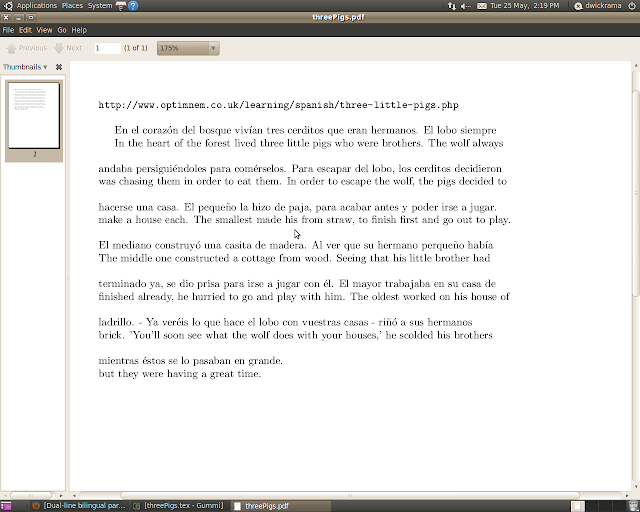An interlinear gloss can be used to layout a translation of a document.
http://en.wikipedia.org/wiki/Interlinear_gloss
Usually this is done word-by-word or morpheme-by-morpheme. However, I would like to do this in a different way, translating entire paragraphs at a time. The following link and image is an example of what I want done, though I want to do it for a different text which is larger.
http://www.optimnem.co.uk/learning/spanish/three-little-pigs.php

For now I am not interested in taking into account the order of words or phrases that change order between languages. That is, I don't mind if the words in the paragraph are not aligned or if the length of one paragraph is much longer than the other, causing an overhanging line.
As far as I can tell, the following packages do not meet my needs:
covingtn.sty
cgloss4e.sty
gb4e.sty
lingmacros.sty - shortex
Here is the english version:
In the heart of the forest lived three little pigs who were brothers. The wolf always was chasing them in order to eat them. In order to escape the wolf, the pigs decided to make a house each. The smallest made his from straw, to finish first and go out to play. The middle one constructed a cottage from wood. Seeing that his little brother had finished already, he hurried to go and play with him. The oldest worked on his house of brick. 'You'll soon see what the wolf does with your houses,' he scolded his brothers but they were having a great time.
Here is the spanish version:
En el corazón del bosque vivían tres cerditos que eran hermanos. El lobo siempre andaba persiguiéndoles para comérselos. Para escapar del lobo, los cerditos decidieron hacerse una casa. El pequeño la hizo de paja, para acabar antes y poder irse a jugar. El mediano construyó una casita de madera. Al ver que su hermano perqueño había terminado ya, se dio prisa para irse a jugar con él. El mayor trabajaba en su casa de ladrillo. - Ya veréis lo que hace el lobo con vuestras casas - riñó a sus hermanos mientras éstos se lo pasaban en grande.
I don't want to do it manually like this:
\documentclass{article}
\usepackage[margin=1in, paperwidth=8.5in, paperheight=11in]{geometry}
\usepackage[utf8]{inputenc}
\usepackage{url}
\begin{document}
\noindent
\url{http://www.optimnem.co.uk/learning/spanish/three-little-pigs.php}\\
\\
\indent
En el corazón del bosque vivían tres cerditos que eran hermanos. El lobo siempre\\
\indent
In the heart of the forest lived three little pigs who were brothers. The wolf always\\
\\
%
andaba persiguiéndoles para comérselos. Para escapar del lobo, los cerditos decidieron\\
was chasing them in order to eat them. In order to escape the wolf, the pigs decided to\\
\\
%
hacerse una casa. El pequeño la hizo de paja, para acabar antes y poder irse a jugar.\\
make a house each. The smallest made his from straw, to finish first and go out to play.\\
\\
%
El mediano construyó una casita de madera. Al ver que su hermano perqueño había\\
The middle one constructed a cottage from wood. Seeing that his little brother had\\
\\
%
terminado ya, se dio prisa para irse a jugar con él. El mayor trabajaba en su casa de\\
finished already, he hurried to go and play with him. The oldest worked on his house of\\
\\
%
ladrillo. - Ya veréis lo que hace el lobo con vuestras casas - riñó a sus hermanos\\
brick. 'You'll soon see what the wolf does with your houses,' he scolded his brothers\\
\\
%
mientras éstos se lo pasaban en grande.\\
but they were having a great time.\\
\\
\end{document}\\
I would like to use a package or a macro to automatically have the english and spanish texts interspersed with line breaks when the end of the line has been reached for each. How can I layout this simple dual-line biligual paragraph in Latex in a more automated way (without manually adding line breaks)?
